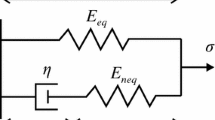Abstract
Incompressible nonlinearly hyperelastic materials are rarely simulated in finite element numerical experiments as being perfectly incompressible because of the numerical difficulties associated with globally satisfying this constraint. Most commercial finite element packages therefore assume that the material is slightly compressible. It is then further assumed that the corresponding strain-energy function can be decomposed additively into volumetric and deviatoric parts. We show that this decomposition is not physically realistic, especially for anisotropic materials, which are of particular interest for simulating the mechanical response of biological soft tissue. The most striking illustration of the shortcoming is that with this decomposition, an anisotropic cube under hydrostatic tension deforms into another cube instead of a hexahedron with non-parallel faces. Furthermore, commercial numerical codes require the specification of a ‘compressibility parameter’ (or ‘penalty factor’), which arises naturally from the flawed additive decomposition of the strain-energy function. This parameter is often linked to a ‘bulk modulus’, although this notion makes no sense for anisotropic solids; we show that it is essentially an arbitrary parameter and that infinitesimal changes to it result in significant changes in the predicted stress response. This is illustrated with numerical simulations for biaxial tension experiments of arteries, where the magnitude of the stress response is found to change by several orders of magnitude when infinitesimal changes in ‘Poisson’s ratio’ close to the perfect incompressibility limit of 1/2 are made.
Similar content being viewed by others
References
Abaqus Analysis User’s Manual, version 6.10. https://www.sharcnet.ca/Software/Abaqus610/Documentation/docs/v6.10/books/usb/default.htm.
Adams LH, Gibson RE (1930) The compressibility of rubber. J Wash Acad Sci 20: 213–223
Beatty MF, Stalnaker DO (1986) The poisson function of finite elasticity. J Appl Mech 53: 807–813
Bonet J, Wood R (2008) Nonlinear continuum mechanics for finite element analysis. University Press, Cambridge
Bridgman PW (1944) The compression of sixty-one solid substances to 25000 kg cm2, determined by a new rapid method. Proc Am Acad Arts Sci 76: 9–24
Carew TE, Vaishnav RN, Patel DJ (1968) Compressibility of the arterial wall. Circ Res 23: 61–68
Christensen RG, Hoeve CAJ (1970) Comparison between theoretical and experimental values of the volume changes accompanying rubber extension. J Polym Sci A 1(8): 1503–1512
Chuong CJ, Fung YC (1984) Compressibility and constitutive equation of arterial wall in radial compression experiments. J Biomech 17: 35–40
Crisfield MA (1991) Nonlinear finite element analysis of solids and structures. Volume 1: Essentials. Wiley, New York
Destrade M, Gilchrist MD, Motherway J, Murphy JG (2012) Slight compressibility and sensitivity to changes in Poisson’s ratio. Int J Numer Meth Eng 90: 403–411
Erdemir A, Guess TM, Halloran J, Tadepalli SC, Morrison TM (2012) Considerations for reporting finite element analysis studies in biomechanics. J Biomech 45: 625–633
FEBio Documentation, http://mrl.sci.utah.edu/software/febio. 2012
Fong JT, Penn RW (1975) Construction of a strain-energy function for an isotropic elastic material. Trans Soc Rheol 19: 99–113
Gasser TC, Ogden RW, Holzapfel GA (2006) Hyperelastic modelling of arterial layers with distributed collagen fibre orientation. J R Soc Interface 3: 15–35
Gent AN, Suh JB, Kelly SG III (2007) Mechanics of rubber shear springs. Int J Nonlinear Mech 42: 241–249
Hearmon, RF (1974) The elastic constants of crystals and other anisotropic materials. In: Hellwege KH (ed) Landolt-Börnstein Tables, Group III, vol 11, pp 1–154
Holzapfel GA (2000) Nonlinear solid mechanics. Wiley, Chichester
Holzapfel GA, Gasser TC, Ogden RW (2000) A new constitutive framework for arterial wall mechanics and a comparative study of material models, J. Elasticity 61: 1–48
Holzapfel GA, Stadler M, Schulze-Bauer CAJ (2002) A layer-specific three-dimensional model for the simulation of balloon angioplasty using magnetic resonance imaging and mechanical testing. Ann Biomed Eng 30: 753–767
Horgan CO, Murphy JG (2009a) Constitutive modeling for moderate deformations of slightly compressible rubber. J Rheol 53: 153–168
Horgan CO, Murphy JG (2009b) On the volumetric part of strain-energy functions used in the constitutive modeling of slightly compressible solid rubbers. Int J Solids Struct 46: 3078–3085
LS-DYNA Keyword User’s Manual, version 971 (2007) Livermore Software Technology Corporation
Ní Annaidh A, Bruyère K, Destrade M, Gilchrist MD, Maurini C, Otténio M, Saccomandi G (2012a) Automated estimation of collagen fibre dispersion in the dermis and its contribution to the anisotropic behaviour of skin. Ann Biomed Eng 40: 1666–1678
Ní Annaidh A, Bruyère K, Destrade M, Gilchrist MD, Otténio M (2012b) Characterising the anisotropic mechanical properties of excised human skin. J Mech Behav Biomed Mater 5: 139–148
Ogden RW (1997) Nonlinear elastic deformations. Ellis Horwood, Chichester (1984). Reprinted by Dover, New York
Ogden RW (2003) Nonlinear elasticity, anisotropy, material stability and residual stresses in soft tissue, CISM courses and lectures series no. 441. Springer, Wien, 65–108
Penn RW (1970) Volume changes accompanying the extension of rubber. Trans Soc Rheol 14: 509–517
Rashid B, Destrade M, Gilchrist MD (2012a) Mechanical characterization of brain tissue in compression at dynamic strain rates. J Mech Behav Biomed Mater 10: 23–38
Rashid B, Destrade M, Gilchrist MD (2012b) Mechanical characterization of brain tissue in tension at dynamic strain rates. J Mech Behav Biomed Mater. doi:10.1016/j.jmbbm.2012.07.015
Simo JC, Taylor RL (1991) Quasi-incompressible finite elasticity in principal stretches. Continuum basis and numerical algorithms. Comput Methods Appl Mech Eng 85: 273–310
Sansour C (2008) On the physical assumptions underlying the volumetric-isochoric split and the case of anisotropy. Eur J Mech A Solids 27: 28–39
Vito RP, Dixon SA (2003) Blood vessel constitutive models—1995–2002. Annu Rev Biomed Eng 5: 413–439
Weiss JA, Makerc BN, Govindjeed S (1996) Finite element implementation of incompressible, transversely isotropic hyperelasticity. Comput Methods Appl Mech Eng 135: 107–128
Author information
Authors and Affiliations
Corresponding author
Rights and permissions
About this article
Cite this article
Ní Annaidh, A., Destrade, M., Gilchrist, M.D. et al. Deficiencies in numerical models of anisotropic nonlinearly elastic materials. Biomech Model Mechanobiol 12, 781–791 (2013). https://doi.org/10.1007/s10237-012-0442-3
Received:
Accepted:
Published:
Issue Date:
DOI: https://doi.org/10.1007/s10237-012-0442-3




